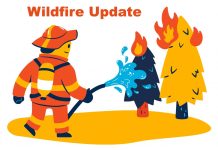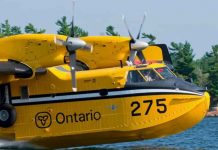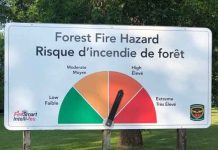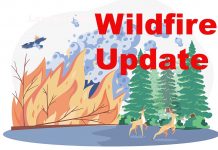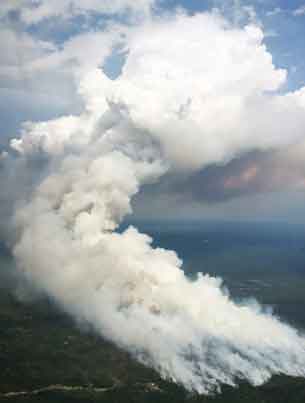
carried out with four CL-415 heavy waterbombers on the fire and once it is safe, FireRanger crews will be positioned for ground attack.
Thirty New Forest Fires in Northwestern Ontario
THUNDER BAY – The forest fire situation has escalated through the Northwest Region with upwards of 30 new fires in a day and many northern communities affected by smoke and fires in the surrounding areas. Ontario has brought in aviation resources from the Great Lakes Forest Fire Compact and Quebec as well as FireRangers from the Northeast Region in Ontario. Type 2 contract crews are also joining Type 1 FireRanger crews on these fires.
There were 14 new fires confirmed by the afternoon of August 13 in the Northwest Region and 33 new fires confirmed by day’s end on August 12. Despite a number of small fires being declared out, multiple fires remain active in the region, totaling 155 active fires at the time of this report.
Hot, windy conditions and a pattern of lightning strikes across the region are expected to keep the situation volatile for several days. Although rain is in the forecast to the south, this is expected to bring more lightning and the possibility of little rain to offset the strikes. Active fires are expected to grow in size in the coming days.
Currently Quebec is assisting Ontario in the Northwest Region with two CL-415 water-bombers. Minnesota has also provided a Tactical Aircraft capable of air attack or transport as required.
Many of the fires are occurring in close proximity to each other as a result of lightning tracking through with storm systems. This has resulted in fire complexes and the Aviation, Forest Fire and Emergency Services program is dedicating management teams and resources to them. There is an Incident Management Team established in Nibinamik First Nation about 500 kilometres North of Thunder Bay to manage a complex of four fires that are to the north and northwest of the community.
Due to a power outage and smoke issues a decision was made by the community to evacuate residents to the host town of Kapuskasing. The Ministry of Natural Resources and Forestry (MNRF) coordinated commercial aircraft for the evacuation. MNRF coordinates its response with the Office of the Fire Marshall and Emergency Management via the Provincial Emergency Operations Centre which continues to work with community leaders, federal departments, non-government organizations and provincial government ministries to support the community.
Other northern First Nation communities with fire management resources on site to manage fires include Kitchenuhmaykoosib Inninuwug (KI), Deer Lake, Wunnumin Lake, Eabametoong, Neskantaga and Sandy Lake.
One fire of note that may cause smoky conditions along the TransCanada highway north of Nipigon is fire number 099 in the Kama Hill area. Travelers may encounter reduced visibility after sunset and through the night but these conditions will gradually improve once the sun rises on Monday morning.
A smoke column was visible from the TransCanada highway and Nipigon as it burned in the Kama Hill Area. Aggressive air attack was carried out with four CL-415 heavy waterbombers on the fire and once it is safe, FireRanger crews will be positioned for ground attack.
Armstrong was also under a heavy smoke haze on August 13 due to northern fires, but no fires in close proximity to the community.
Multiple fire starts are the characteristic of new fires occurring daily in the Northwest Region. Pictured above are two lightning-caused fires, Sioux Lookout Fire 068 and 096.
The majority of the new fires are caused by lightning but some are still attributed to human-causes.
To track the fire hazards and to see a complete list of fires across the province click on our interactive map. You can also get the latest update on the condition of any fire by clicking the fire icons.
Out of Province Deployment
- Currently there are over 60 staff supporting the province of British Columbia in their fire management efforts.
- Ontario continues to have firefighting staff on the ground in British Columbia to help support ongoing firefighting efforts. This is being done while also ensuring we have the necessary firefighting personnel here at home.
The public is urged to take an active role in preventing more fires. This can be done by not burning when it is windy, monitoring your fire and ensuring that you have water nearby to extinguish your fire. As a reminder, there is no day burning of brush and grass.
Planning to have a campfire?
Here are some tips on how to safely enjoy your campfire and avoid the costs and dangers that can arise from an unextinguished or unattended campfire:
- Choose your site carefully. Select a site with easy access to water that is sheltered from high winds. The fire must be built on bare rock or non-combustible material.
- Prepare the site. Clear a one metre space around your campfire site and remove all pine needles, grasses, leaves and twigs.
- Keep your fire small. By law, your campfire cannot exceed one metre in height and one metre in diameter.
- Stay nearby. Never leave your campfire unattended.
- Put your fire out. Soak your fire with water.
- Be sure the fire is extinguished. Stir the ashes with a stick to uncover hot coals and then soak it again!
Ontario has increased the maximum fines for individuals and corporations for starting forest fires.
Increased Fines for Starting a Forest Fire
Fire numbers and online information:
- Forest Fire Reporting Number – 310-FIRE (3473)
- Follow us on Twitter: in English @ONForestFires or in French @ONFeuDeForêt
- For guidelines on safe outdoor fire management ontario.ca/fireprevention


